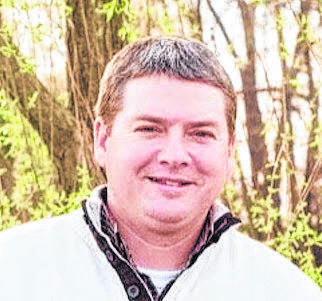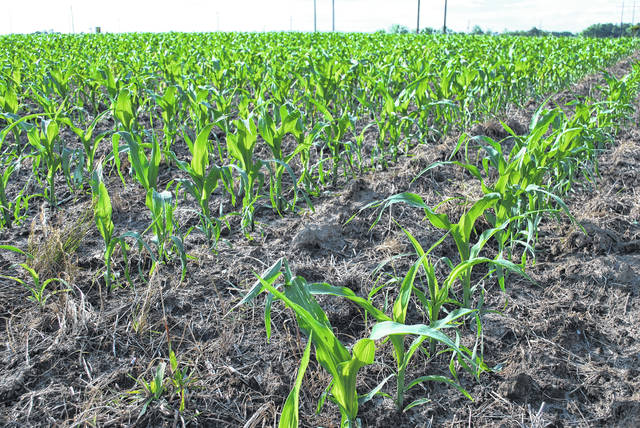Lack of rain threatens crops, raises fire risk
LUMBERTON — Robeson County is in a drought that has the potential to adversely affect crops and increase the risk for fires, according to officials.
Robeson is one of 12 counties in the state identified by the North Carolina Drought Management Advisory Council as moderate drought areas because of low rainfall, according to the N.C. Department of Environmental Quality. Moderate drought is considered the “least severe” drought classification. However, the northern half of Robeson County was classified as abnormally dry as of Tuesday.
“After a wet winter, rainfall has been below normal since March in much of eastern North Carolina. By May 4, we had parts of 45 counties that were considered to be abnormally dry. Conditions have continued to deteriorate in the southeastern coastal plain and along the coast resulting in the moderate drought declaration,” said Klaus Albertin, DMAC chairman.
“We are not seeing water supply issues in our reservoirs and rivers yet, but residents should follow the water restrictions as they are put in place by their local water systems. Water restrictions help reduce the risk of water shortages if current weather conditions continue,” he added.
In the past six months, Lumberton has benefited from 21.24 inches of rain, which is 120% of normal, said Steve Pfaff, Warning Coordination meteorologist at the National Weather Service office in Wilmington. However, conditions in the past 30 days have left Lumberton with about 1.58 inches of rain, which is about 53% of normal rainfall for the area.
Next week’s forecast doesn’t appear to break recent weather trends. The NWS predicts no rainfall through Friday.
The drought’s effects on agriculture are certain and fire susceptibility rises because of the lack of rainfall.
“So it’s a double edged sword basically,” Pfaff said.
The hot temperatures could affect the strawberry growing season in Robeson County, said Mac Malloy, Field Crop agent with the N.C. Cooperative Extension Service, Robeson County Center.
“I think it’s just gonna be a shorter growing season,” he said of strawberries.
Fruits came quickly, and almost all at once when plants matured, Malloy said.
Some farmers stopped planting soybeans because of the dry weather, he said. They are waiting for more soil moisture before planting.
Cool night temperatures have not been conducive to the planting of peanuts or cotton, Malloy said. And cotton must be planted by May 25.
“Our wheat crop is probably most at risk for the dry weather,” he said.
The crop’s grain yield and quality could be affected by the weather conditions, Malloy said.
Wheat was planted near the end of October and is to be harvested at the end of the month or in early June.
“There’s a varying crop status right now,” he said.
The storms that swept through Robeson County on May 7 brought some rain and hail that affected the county differently from area to area.
Crops in the northern portion of Robeson County, including the Parkton and Lumber Bridge areas, were affected by the storm, resulting in leaves being stripped from corn, according to Malloy. And assessments are “ongoing” for damaged blueberries in the areas.
Damages to corn are dependent on the growing stage in which the plants are in, according to Malloy. If they are older, they may not easily regenerate.
As of Thursday, Malloy hadn’t heard of total losses of plants in the county because of the storm.
“We just need to keep an eye on soil moisture and you know, plant when conditions are good,” Malloy said.
Robeson County Ranger Robby Freeman said county residents should be careful not to start a fire during the drought. During a drought, fires can have random causes, and fires can be caused by something simple.
“Non-typical fire starts are what we get,” he said.
One example is a fire started by a vehicle hot from traveling on the interstate for hours, according to the ranger. If the vehicle pulls to the side of the road and comes in contact with tall, dry grass, the grass could catch fire.
Freeman encourages county residents to “be more mindful” during the drought.
People should never leave a fire unattended, he said. The ranger also encourages campers to follow Smokey Bear’s advice and drown a camp fire with water until it’s cold to the touch.
However, there is a “silver lining” to the lack of rainfall in Robeson County, according to meteorologist Steve Pfaff.
“At least the river levels will be able to come down,” he said.
Those levels could act as a buffer as hurricane season, June 1 through Nov. 30, approaches.
“Our rivers aren’t near flood stage as we head into hurricane season,” Pfaff added.
More than 30 other counties in central and eastern parts of the state have areas that are experiencing “abnormally dry conditions,” according to NCDEQ. Those locations could face severe droughts “if dry conditions persist.”
“Drought categories are based on streamflow, groundwater levels, the amount of water stored in reservoirs, soil moisture, the time of year and other relevant factors for assessing the extent and severity of dry conditions,” according to the NCDEQ.
“While 2020 ended by becoming our state’s second-wettest year on record, and 2021 started with wet weather through the winter, we’ve seen that precipitation pattern reverse this spring, from having too much rain to suddenly not enough across much of North Carolina,” said Corey Davis, of the N.C. State Climate Office.
“The southern and central coast continues to miss out on regular rainfall and is now at a deficit of 4 to 6 inches since the beginning of March. Sites including Lumberton, Wilmington and New Bern are all on pace for one of their top 10 driest springs on record,” Davis said.
Reach Jessica Horne at 910-416-5165 or via email at [email protected].








